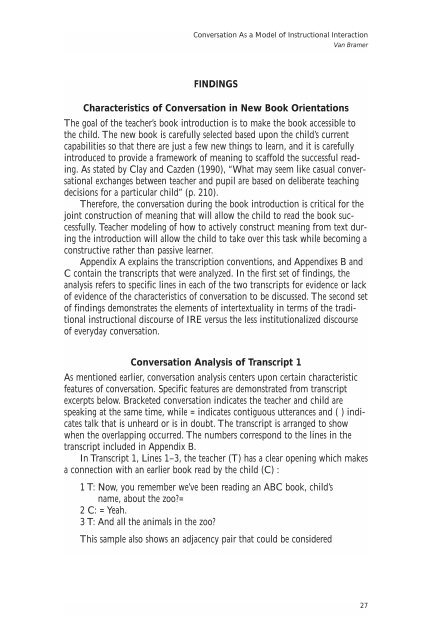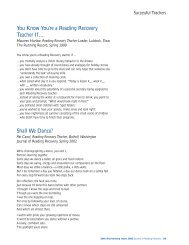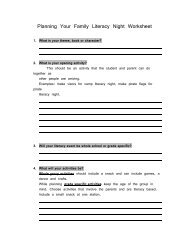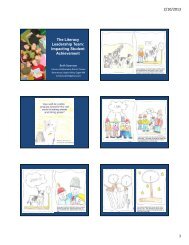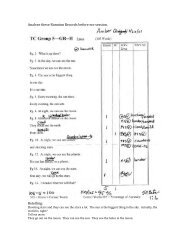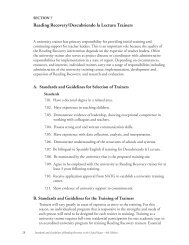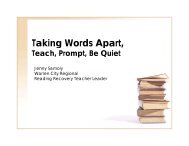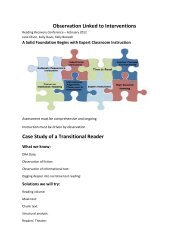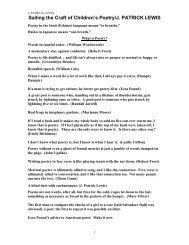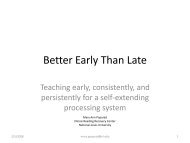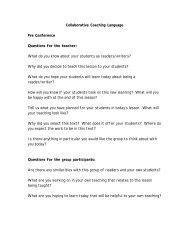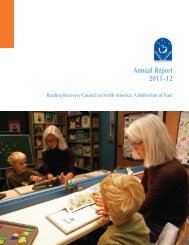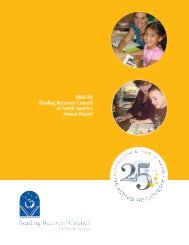Conversation As a Model of Instructional Interaction - Eric
Conversation As a Model of Instructional Interaction - Eric
Conversation As a Model of Instructional Interaction - Eric
Create successful ePaper yourself
Turn your PDF publications into a flip-book with our unique Google optimized e-Paper software.
layout-8/l-2003 1/7/04 12:29 PM Page 27<strong>Conversation</strong> <strong>As</strong> a <strong>Model</strong> <strong>of</strong> <strong>Instructional</strong> <strong>Interaction</strong>Van BramerFINDINGSCharacteristics <strong>of</strong> <strong>Conversation</strong> in New Book OrientationsThe goal <strong>of</strong> the teacher’s book introduction is to make the book accessible tothe child. The new book is carefully selected based upon the child’s currentcapabilities so that there are just a few new things to learn, and it is carefullyintroduced to provide a framework <strong>of</strong> meaning to scaffold the successful reading.<strong>As</strong> stated by Clay and Cazden (1990), “What may seem like casual conversationalexchanges between teacher and pupil are based on deliberate teachingdecisions for a particular child” (p. 210).Therefore, the conversation during the book introduction is critical for thejoint construction <strong>of</strong> meaning that will allow the child to read the book successfully.Teacher modeling <strong>of</strong> how to actively construct meaning from text duringthe introduction will allow the child to take over this task while becoming aconstructive rather than passive learner.Appendix A explains the transcription conventions, and Appendixes B andC contain the transcripts that were analyzed. In the first set <strong>of</strong> findings, theanalysis refers to specific lines in each <strong>of</strong> the two transcripts for evidence or lack<strong>of</strong> evidence <strong>of</strong> the characteristics <strong>of</strong> conversation to be discussed. The second set<strong>of</strong> findings demonstrates the elements <strong>of</strong> intertextuality in terms <strong>of</strong> the traditionalinstructional discourse <strong>of</strong> IRE versus the less institutionalized discourse<strong>of</strong> everyday conversation.<strong>Conversation</strong> Analysis <strong>of</strong> Transcript 1<strong>As</strong> mentioned earlier, conversation analysis centers upon certain characteristicfeatures <strong>of</strong> conversation. Specific features are demonstrated from transcriptexcerpts below. Bracketed conversation indicates the teacher and child arespeaking at the same time, while = indicates contiguous utterances and ( ) indicatestalk that is unheard or is in doubt. The transcript is arranged to showwhen the overlapping occurred. The numbers correspond to the lines in thetranscript included in Appendix B.In Transcript 1, Lines 1–3, the teacher (T) has a clear opening which makesa connection with an earlier book read by the child (C) :1 T: Now, you remember we’ve been reading an ABC book, child’sname, about the zoo?=2 C: = Yeah.3 T: And all the animals in the zoo?This sample also shows an adjacency pair that could be considered27


